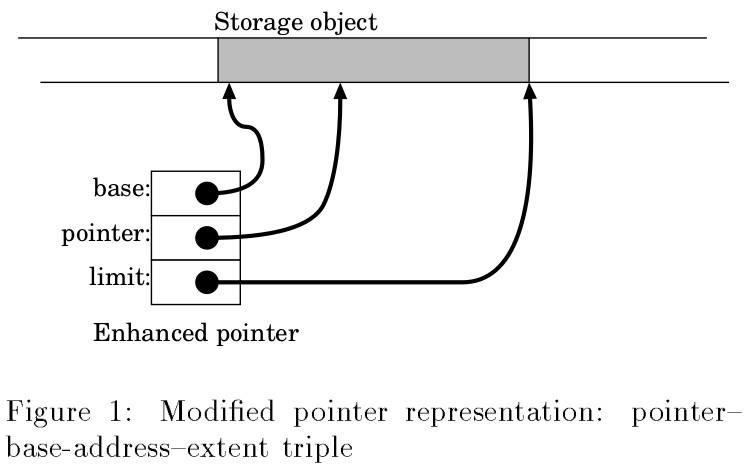Jones Kelly
Reference1
Earlier work:

In this work,
- pointer representations are not changed.
A table of all known valid storage objects:
- mapping a pointer to an object descriptor;
- the descriptor contains the base, extent and additional information of the object.
All pointer arithmetic and pointer use are checked.
- arithmetic result must refer to the same object;
- every pointer-valued expression must derive its result from one original object.
- Incorrectly derived pointers are replaced with an illegal pointer value (
(void *)-2).
Example: pointers to objects.

Permitted operations for pointers above:

Object/pinter tracking: track object when created/deleted:
- static: global variables, static variables in functions, and string constants: compiler/linker change.
- dynamic: malloc/free/mmap/sbrk: C library change.
stack objects:
- Each object is padded by 1 byte. GCC
allocafunction. De-register: constructor/destructor mechanism. The following compilation happens:
int sum (int n, int *a){ int i, s = 0; for (i = 0; i < n; ++i) s += a[i]; return s; }
- Each object is padded by 1 byte. GCC
Compiled to
int sum (int n, int *a){
/* bounds push function enters a function context. A
* matching call to bounds pop function will
* delete parameters.
*/
__bounds_push_function ("sum");
__bounds_add_parameter_object (&n, sizeof (int), ...);
__bounds_add_parameter_object (&a, sizeof (int*), ...);
/* Extra scope created around the function. GCC will
* call bounds pop function when leaving this
* scope.
*/
{
/* Declare stack objects, and use GCC's destructor
* mechanism to ensure __bounds_delete_stack_object is
* called for each variable however we leave scope
* (even if we leave with goto).
*/
int i;
__bounds_add_stack_object (&i, sizeof (int), ...);
int s = u;
__bounds_add_stack_object (&s, sizeof (int), ...);
for (i = 0; i < n; ++i)
s += *(int*)__bounds_check_array_reference(a, i, sizeof (int), ...);
__bounds_delete_stack_object(&s);
__bounds_delete_stack_object(&i);
}
end;
__bounds_pop_function("sum"); /* Delete a, n. */
return s;
}goto example. Figure 4: goto label1 creates b and goto label2 destroys b.

Corner Cases:
- pointers passed from unchecked code to checked code:
- If points to registered object: can be derived from another object (registered or unregisterd), cannot detect.
- If points to unregistered object: can detect and report, but allow such error.
- pointers passed from checked code to unchecked code:
- unchecked accesses can occur.
Splay trees to look up pointers:
- Binary tree where frequently used nodes migrate towards the top of the tree;
- on average, the look-up function was iterated 2.11 times per call on a typical large program. unrolled first two iterations of the loop to optimise these cases.
A Brief summary from ICSE 20062
Jones-Kelly inserts the following checks (ignoring any later optimizaiton) on each arithmetic operation involving a pointer value:
- JK1. check the source pointer is not the invalid value (-2);
- JK2. find referent object for the source pointer value using the table;
- JK3. check that the result pointer value is within the bounds of this referent object plus the extra byte. If the result pointer exceeds the bounds, the result -2 is returned to mark the pointer value as valid.
- JK4. Finally, on any load or store, perform checks[JK1-JK3] but JK3 checks the source pointer itself.
- Backwards-compatible bounds checking for arrays and pointers in C programs, here. In Automated & Algorithmic Debugging, 1997. ↩
- Backwards-Compatible Array Bounds Checking for C with Very Low Overhead, ICSE, 2006. ↩
If you could revise
the fundmental principles of
computer system design
to improve security...
... what would you change?